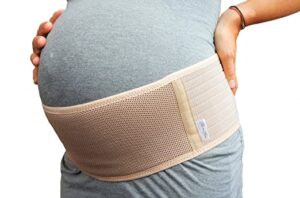Hip pain can come in many forms, especially during pregnancy. The hip joint itself sits deep within your upper thigh (roughly below where your fingers land, when you put your hand in your front, jeans pocket), this could be where you feel your hip pains. Another area that we associate with hip pain is the outside of our upper leg (the part you are told to lie on in bed) and this is likely to be caused by a tendon / muscle issue.
Symptoms:
-
Around 20% of ladies experience some sort of hip pain during their pregnancy.
-
Hip pains can start at any point during pregnancy but they are more likely towards the end of your second and in your third trimester as the baby grows and makes changes to your posture and weight.
-
The pain may be focused on the side or the back of the hip, the groin or buttock.
-
Pain may feel like a dull ache or be sharp and stabbing.
-
Stiff feeling and pain in the hip which is often worse after prolonged sitting.
-
Pain / aching may be inner hip or groin area and associated with a locking clicking / catching feeling.
-
The pain might be a dull ache in buttock which can occasionally travel down the back of thigh also.
-
There might be a reduction in the range of movement available at the hip.
-
The pain / symptoms might cause a limp. It might feel difficult getting up from sitting, going upstairs, and lying on the affected side.
Causes:
-
Change in hormones affecting ligament laxity and mobility in the joint.
-
Increased weight being put through hips due to growing baby.
-
Poor posture or change in posture. This causes stress on hips at an angle that the hip joints may not be used to.
-
A history of hip pain or injury.
-
Transient osteoporosis. This condition typically begins sometime in the second or third trimester and may be related to calcium and potassium levels. You may experience pain in the hips or groin. To get a proper diagnosis, you’ll need an MRI so please speak to your midwife or GP if you are worried about your hip pain. Symptoms associated with transient osteoporosis tend to resolve shortly after birth.
Here is what the evidence says about the treatment options:
Pilates – evidence does support the use of Pilates-based exercise during pregnancy for the treatment of many conditions, including pelvic / hip related pains. Evidence has also shown that Pilates can also have a positive effect on the birth and the outcome following the birth also.
Have a look at our Top 5 online Pilates programmes here.
Yoga – evidence suggests that prenatal yoga may help reduce pelvic and hip related pains and help to improve mental health conditions like stress, depression, anxiety that can be associated with pain in pregnancy. Yoga has also been shown to help with pain and pleasure at the delivery of the baby and with perinatal outcomes such as lower delivery times and obstetrical complications.
There are lots of Online Yoga programmes available, have a look at our Top 5 here (and why we love them)! You can also read our blog on how yoga can help in other ways.

Pregnancy support Pillow – There is little evidence in support of the pregnancy pillow. That’s not to say that it doesn’t work / help, it just means that there hasn’t been a need to carry out studies on them. A pregnancy pillow aims to help keep your spine and hips in a neutral position whilst lying on your side. I know from personal experience that they are very comfortable and can double up as a feeding pillow once the baby is born, I think they’re a good investment but whether they will help to alleviate hip pain – the jury is still out on that one.
Have a look at out Top 5 pregnancy pillows available here.
Pelvic Support Belt – evidence supports the use of pelvic support belts in pregnancy for ladies with hip pain / weakness and pelvic girdle pain. THIS study showed that Pelvic Support belts were a great option in the short term when compared to exercises.
There are currently no studies to show which support belts work best or for how long you should be wearing them, so we have put together our top 5 choices (here) to help guide you based on what they can help with and what we like about them.
Heat – Evidence suggests that heat can be beneficial (particularly in the short term) for pain relief in the back and when it comes to pelvic or period-type pains. Heat helps to increase blood flow to the desired area, resulting in more relaxed muscles and a reduction in static fluids. You can use a hot-water bottle as a good heat source or get yourself a wheat-bag that you heat in the microwave (the heat from these usually last about 15 minutes). There is also the option of the heat patches like these which last about 12hrs and are self adhesive.
TENS – TENS as a treatment for hip pain is a little under researched. Studies have shown it’s effectiveness in relieving pain but this is usually post-operative pain and often associated with the elderly.
There are many different TENS machines available to buy, so if you are thinking of TENS as a treatment option then have a look at our Top 5 picks to make things a little easier.
Symptoms to watch for:
If you experience any of the following symptoms during or after your pregnancy please tell your GP / healthcare provider or call 111 to discuss treatment options.
-
Severe hip pain that started suddenly but you’ve not had a fall or injured your hip.
-
Swelling / heat coming from the hip region.
-
Changes to the skins colour in the hip area.
-
Hip pain which is also associated with you feeling unwell with a high temperature.
-
Severe hip pain after a fall or injury.
-
Inability to walk or put weight on your leg.
-
Tingling or loss of feeling in your hip or leg after an injury.





